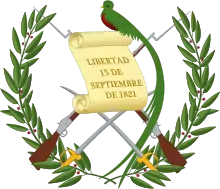| |||||||||||||||||
| |||||||||||||||||
| |||||||||||||||||
| This article is part of a series on |
| Politics of Guatemala |
|---|
 |
|
|
Presidential elections were held in Guatemala between 17 and 19 December 1944.[1] The October Revolution had overthrown Jorge Ubico, the American-backed dictator,[2] after which a junta composed of Francisco Javier Arana, Jacobo Árbenz and Jorge Toriello took power, and quickly announced presidential elections, as well as elections for a constitutional assembly.[3] The subsequent elections were broadly considered free and fair,[4] although only literate men were given the vote.[5] Unlike in similar historical situations, none of the junta members stood for election.[4] The front-runner was the philosophically conservative University professor Juan José Arévalo, of the National Renovation Party. His closest challenger was Adrián Recinos, whose campaign included a number of individuals identified with the Ubico regime.[4] The ballots were tallied on 19 December and Arévalo won in a landslide with 86.25% of the vote, receiving more than four times as many votes as the other candidates combined.[4] The Constitutional Assembly elections took place on 28–30 December, with the United Front of Arevalist Parties winning 50 of the 65 seats.
Results
| Candidate | Party | Votes | % | |
|---|---|---|---|---|
| Juan José Arévalo | United Front of Arevalist Parties | 255,660 | 86.25 | |
| Adrián Recinos | FND–PDC | 20,949 | 7.07 | |
| Manuel María Herrera | Workers Republican-Democratic Party | 11,062 | 3.73 | |
| Guillermo Flores Avendaño | Social Democratic Party | 8,230 | 2.78 | |
| Teófilo Díaz Medrano | Democratic Constitutionalist Party | 342 | 0.12 | |
| Bernardo Alvarado Tello | Popular Liberation Front | 115 | 0.04 | |
| Ovidio Pivaral | Democratic Party | 22 | 0.01 | |
| Francisco Javier Arana | Popular Liberation | 12 | 0.00 | |
| Clemente Marroquín | National Accord Party | 5 | 0.00 | |
| José Gregorio Díaz | Nationalist Action Party | 5 | 0.00 | |
| Luis Cardoza y Aragón | 3 | 0.00 | ||
| Miguel Ydígoras Fuentes | 2 | 0.00 | ||
| Humberto Robles | 2 | 0.00 | ||
| Jorge Toriello Garrido | Civic Union | 2 | 0.00 | |
| Julio Bianchi | Central-American party | 1 | 0.00 | |
| Manuel Galich | Popular Liberation Front | 1 | 0.00 | |
| Eugenio Silva Peña | Social Democratic Party | 1 | 0.00 | |
| Total | 296,414 | 100.00 | ||
| Valid votes | 296,414 | 98.00 | ||
| Invalid/blank votes | 6,042 | 2.00 | ||
| Total votes | 302,456 | 100.00 | ||
| Registered voters/turnout | 310,000 | 97.57 | ||
| Source: Prensa Libre, Nohlen | ||||
References
- ↑ Dieter Nohlen (2005) Elections in the Americas: A data handbook, Volume I, p323 ISBN 978-0-19-928357-6
- ↑ Stephen M. Streeter (2000) Managing the Counterrevolution: The United States and Guatemala, 1954-1961, pp12–13
- ↑ Piero Gleijeses (1991) Shattered hope: The Guatemalan Revolution and the United States, 1944-1954, pp28–29
- 1 2 3 4 Richard H. Immerman, (1982) The CIA in Guatemala: The Foreign Policy of Intervention, p45
- ↑ Gleijeses, p36
Bibliography
- Villagrán Kramer, Francisco. Biografía política de Guatemala: años de guerra y años de paz. FLACSO-Guatemala, 2004.
- Political handbook of the world 1946. New York, 1945.
- Rodríguez de Ita, Guadalupe. 2003. La participación política en la primavera guatemalteca: una aproximación a la historia de los partidos durante el periodo 1944–1954. México: Universidad Autónoma del Estado de México, Universidad Nacional Autónoma de México.
- El estado y los partidos politicos en Guatemala, 1944–1951. by José Campang Chang Published in 1992, Universidad de San Carlos de Guatemala ([Guatemala])
- Castillo, R. Geografía Electoral de Guatemala, Guatemala, INCEP, 1972.
.jpg.webp)
